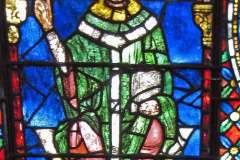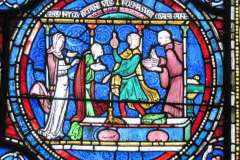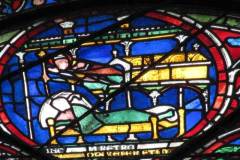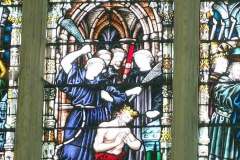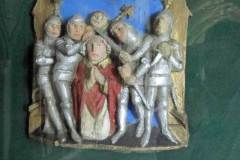(1118-1170) Statesman & Archbishop who in death became the greatest medieval healing saint
Thomas Becket has a personal identification with Canterbury cathedral which is stronger than any other individual. Between his death in 1170 and the destruction of his shrine in 1538, hundreds of thousands of pilgrims visited the main Becket sites in search of blessings or cures: the martyrdom, the first burial place in the crypt, the shrine in the Trinity chapel, and the surrounding miracle windows (north and south).
Becket was born in London within earshot of Bow bells, a French speaking son of Norman parents who had moved to London 50 years after the Norman conquest. He attended school in London, spent two years studying in Paris, and returned to London for work with a financier. He then joined the household of Theobald Archbishop of Canterbury as a minor cleric. By 1154 he was Archdeacon of Canterbury, by 1155 Chancellor to the new king, Henry II, and by 1162 Archbishop of Canterbury. But, following his refusal to accept new rules and procedures governing state and church powers (known as the Constitutions of Clarendon), and a public trial, Thomas fled in November 1164, sailing into exile in a skiff from Sandwich without luggage. The exile lasted six years and led to an uneasy truce in 1170. Thomas returned to Canterbury, welcomed by large crowds and bells pealing. What happened during December that year is one of the better attested series of events in English medieval history. In Normandy, King Henry, livid that Thomas had excommunicated the archbishop of York and bishops of London and Salisbury for taking part in the crowning of his son (the future Henry III then aged 15), spoke the words traditionally recorded as ‘Who will rid me of this troublesome priest?’. Four knights, hearing these words, sailed secretly to England and on 29 December 1170, after a night at Saltwood castle, and a rendezvous at a house in Palace Street, killed Becket at the spot since known as the martyrdom. The monks, surprised to see that their Archbishop wore a lice-infested hair shirt against his skin, placed Becket’s body by the high altar for one night, before burying him in the crypt, his resting place for the next 50 years. The healing powers of the blood collected from the martyrdom floor were soon famous. Pilgrims grew in numbers once the cathedral was re-opened in spring 1171, and in February 1173 Becket was declared a saint by Pope Alexander III. The following year, in July 1174, Henry II demonstrated his penance at the tomb. Approaching on foot with a simple smock in place of royal robes from the leper hospital at Harbledown, Henry stopped at St Dunstan’s church where he removed his shoes and walked bare foot to the cathedral. Kneeling at Becket’s tomb, he received lashes from birch rods on his back – five from each bishop present and three from each of 100 monks. Following the great fire of 1174, an elaborate shrine was built in the newly built Trinity chapel. This stayed in place, bedecked with a growing collection of gold, silver, jewellery and other votive offerings, until it was destroyed by the men of Henry VIII – we have a good description from the writings of Erasmus who visited Canterbury in 1513. Many aspects of the Becket story remain the subject of keen debate – how two men who had been so close could so quickly become sworn enemies, what did Henry intend by the words spoken to his knights, did Becket stage-manage a death that he knew he could not avoid, why did he make no attempt to hide or flee, and so on. Some of these are explored in T S Eliot’s verse drama Murder in the cathedral, first performed for the Canterbury festival in the Chapter House in 1935.
What to see:
- the image of Becket in stained glass in the north ambulatory (Image 1)
- the many images of the original tomb in the miracle windows (example in Image 2)
- image of new shrine in north miracle windows (Image 3)
- the stained glass image of the scourging of Henry II in the Chapter House west window (Image 4)
- the modern depiction of the murder of Becket on show in a collection of figures in the cloisters (Image 5) – these are reproductions of original roof bosses which were lost in the 17th century
- the Becket statue in the crypt
Sources: see standard cathedral sources; also Richardson (1990); Guy (2012)
DL

